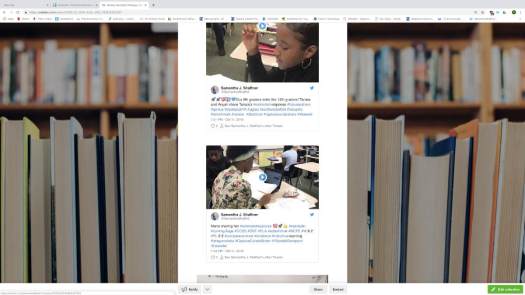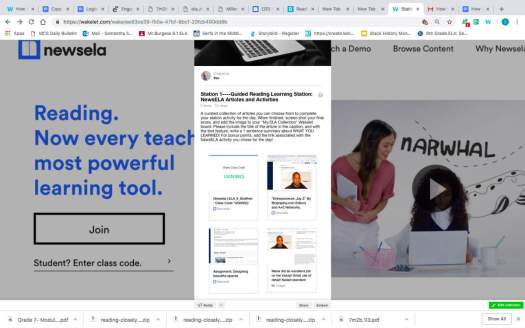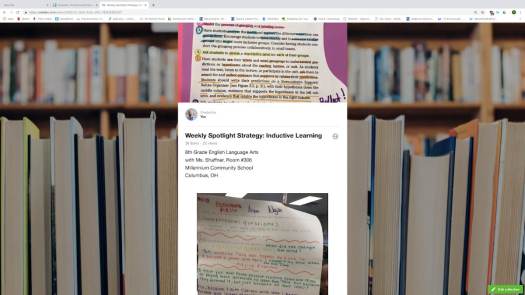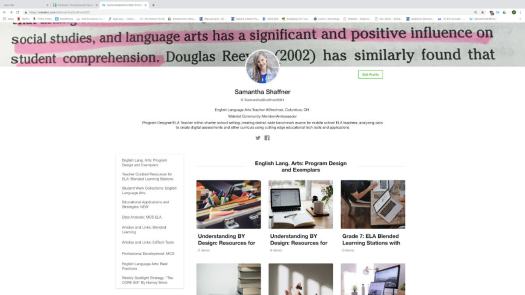How Wakelet can transform the classroom for teachers and students
Wondering how Wakelet could transform your classroom? Teacher Samantha Shaffner shares her experience of using Wakelet
Teachers around the world are using Wakelet to transform classrooms to meet the needs of 21st century students. Wakelet facilitates and supports educational communities by allowing the presentation of engaging educational content in a format that’s easy for both teachers and students to access and follow. Teachers curate information for their students to consume and master in an online environment, while students can do much the same as they organize research projects from a wide variety of digital resources and otherwise express themselves using all of Wakelet’s features.
In this blog post, I’m going to highlight various areas that Wakelet and curation are transforming, or have transformed, education within my ELA classroom and beyond. The images are all from my personal collections, which can be accessed on my Wakelet page.
Wakelet allows its users to curate all media types: videos, links, tweets, Instagram posts, pictures, text, PDFs, and student/teacher commentary.

In the image above, my 8th grade language arts students are demonstrating their reading comprehension skills on a tweeted video post within a Wakelet collection I curated. This content and reflection on the learning experience is being captured, curated, and shared regularly. With some knowledge of social media, students can build upon this skill and develop more sophisticated social media skills while practicing the art of curation within the classroom.
This best practice allows students to reflect on and connect to previous learning experiences. The Wakelet application supports communication by creating a hub for student users to be consistently interacting with their peers about the content they’re posting. Stories and collections of online resources, pictures and notes give teachers powerful tools to transform the classroom and bring the Internet into the classroom.
Bridging the gap
So, why Wakelet? In a word, curation. Wakelet allows educators and scholars to easily integrate and streamline student learning experiences into curated collections that can be used to demonstrate mastery of student learning objectives and other important skills.
Today’s students are constantly swimming in pools of consumable information without much knowledge of how to choose a source that meets their needs. Curating resources for your students surrounding a theme, topic or project allows students to have choice, but also eliminates the chance they’ll waste time with mediocre or poor examples of media and articles needed to complete school projects.
The application also allows students to practice modern social media skills under the supervision of teachers so that they also develop reading, researching and writing skills along the way. Wakelet is easy to use for students and teachers alike.
Many other student friendly features are being developed at Wakelet so be sure to check out their blog, website and social media channels for updates!
In my opinion, Wakelet is the future of the research process in the classroom. Picture this: teachers handpick resources and blended learning tools for students to interact with in class. Students no longer have to twiddle their thumbs and wonder which website might work without glitches or interruptions. With the click of a button, an embedded link leads students to focused research projects and activities created by teachers designing digital curricula.

Above, you can see a collection I created for small group instruction on reading/writing. The text of the image illustrates the process and how students are directed to a collection labelled by the station number (or skill/strategy being practiced). Here, students are prompted to choose between the activities I attached to the collection, all on a similar theme and rigor. Just like any other assessment, students are directed to instructions on how to curate and interact with the items in the collections.
Being clear and focused on what you want the student to demonstrate is very important when teaching students the art of curation. To help students visualize the process, I find it useful to attach exemplars and other visual aides to the assignments.
Student success in a digital age
Although our current students were born in the ‘digital age’ they won’t possess all of the skills required to succeed on digital assignments unless they’re taught and trained by teachers and can practice these new skills regularly. One would assume this generation would be more adaptable to new technologies in the classroom and in testing but this isn’t always the case.
With Wakelet, students can express themselves by curating collections of media containing art and writing. And it doesn’t stop there. The authenticity of the experience is what makes Wakelet a vital 21st century EdTech tool. Students can collaborate with users from any virtual learning community, and gain multiple perspectives while learning about the world they live in.
Many schools, including mine, Millennium Community School, are already adopting Chromebooks and the Schoology platform/Google Apps environment to organize their curricula and provide students access to mature and cloud-based technologies across the world. Learning activities that facilitate curation hosted on Wakelet can be embedded into these learning management systems. With one click, students have access to an almost unlimited amount of high-quality, vetted, and varied pieces of media content.
Moreover, students have opportunities to network with professionals in the Wakelet community that may lead to opportunities to publish their work. To support college and career readiness standards, students are shown how to easily create polished portfolios of their work that are aesthetically pleasing, ongoing, and streamlines. These portfolios will follow them forever, and can be modified and updated as students grow into discerning adults in a digital age.
Personalized Learning
All students, despite learning differences and preferences, can benefit from Wakelet by having access to teacher curated and differentiated resources organized by topic or concept. With just a small amount of training in the application, students can access differentiated activities that meet individual needs to support mastery of common core learning targets.

Take a look at this example of a student work collection. To capture my experiences with students in small group settings, I take several pictures of the student and activities and include dates, instructions and tips to create a personalized learning page. Tracking student learning experiences daily with a variety of media has been a transformative experience in itself and I plan on continuing this practice. It’s helped my students become more successful with their work and more successful in the ELA classroom. Wakelet supports and reinforces classifying and categorizing personal learning experiences through the process of curation to organize class materials and collections of curated work and notes over the course of a class.
Bridging the technology gap
Wakelet, as a user-friendly EdTech tool, can also be used in the classroom for independent research projects, professional networking, and professional development for educators and students. Check out the Professional Development section on my page to see an example of how to stay connected with your school community using Wakelet.
In my ELA classroom, members of our learning community collaborated within Wakelet to create a curation guide/rubric so we could begin tracking daily learning. This practice also provides students the opportunity to reflect on their own learning, as well as receive feedback from teachers, peers, and members of virtual learning communities.
One major benefit Wakelet gives teachers is helping to simplify the research process by curating handpicked resources that are appropriate and, just as importantly, accessible on the school’s network. This prevents those annoying roadblocks that create a lag and loss of instructional time when using the web and other tech to facilitate teaching and learning. This helps maximize focus and instructional time/depth of the learning experience.
Our teachers and students love Wakelet because it gives users instant access to curated resources. It’s like a dream come true, in a world where tech is required but not always supported by the settings, regardless of the intent of the technology or administration. Content organization is also streamlined. Wakelet allows users to consistently upload resources for students, as well as show parents, administrators and other stakeholders what you do in your classroom on a day-to-day basis.
“The Writing Process”
Not all writing is meant to be published and shared. Wakelet has both public and private sharing settings that can be assigned to each collection by the creator only. This makes Wakelet a ‘low anxiety’ EdTech tool and one that’s invaluable in the 21st century classroom. When collections or items are left in Wakelet’s default private mode students can journal regularly and practice note-taking and other types of provisional writing on the platform. In other words, students can play with the platform and in the process learn about writing as well as how to put together projects. Teachers and students can gather photos and other evidence of learning experiences to help track student growth as well as keep resources organized.

Although my classroom’s journey with Wakelet has only just begun, it has already transformed how students access and relate to materials in my ELA classroom, as well as the way I present and organize materials as a teacher. As the application gains new student-friendly features that open up opportunities to learn and share, I plan to continue blogging and informing the EdTech community about how Wakelet has transformed teaching and learning. Curation in the classroom makes learning memorable, retrievable, and a process to build upon, regardless the nature of the content or the learning activity. It’s within these curated projects/collections where students demonstrate mastery and growth that can be archived and reflected on over time.
Samantha is an English Language Arts Teacher @2kschool, Columbus, OH as well as a Wakelet Ambassador. She is also Program Designer/ELA Teacher within charter school setting; creating district wide benchmark exams for middle school ELA teachers; analyzing data to create digital assessments and other curricula using cutting edge educational tech tools and applications
Wakelet profile: @SamanthaShaffner9061
Twitter: @SamanthaShaffn2
LinkdIn: Samantha J. Shaffner


